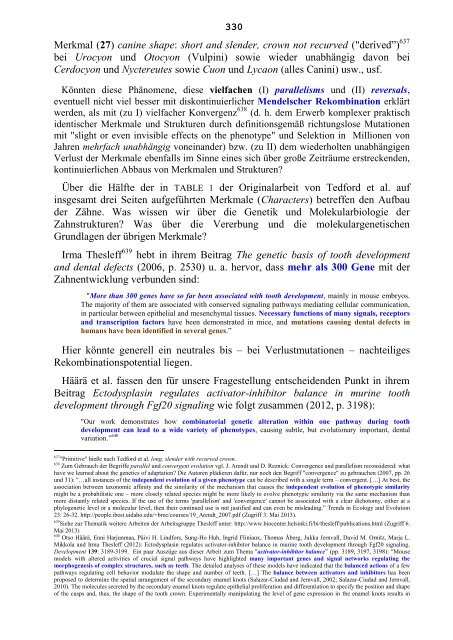Unser Haushund: Eine Spitzmaus im Wolfspelz? - Wolf-Ekkehard ...
Unser Haushund: Eine Spitzmaus im Wolfspelz? - Wolf-Ekkehard ...
Unser Haushund: Eine Spitzmaus im Wolfspelz? - Wolf-Ekkehard ...
Sie wollen auch ein ePaper? Erhöhen Sie die Reichweite Ihrer Titel.
YUMPU macht aus Druck-PDFs automatisch weboptimierte ePaper, die Google liebt.
330Merkmal (27) canine shape: short and slender, crown not recurved ("derived”) 637bei Urocyon und Otocyon (Vulpini) sowie wieder unabhängig davon beiCerdocyon und Nyctereutes sowie Cuon und Lycaon (alles Canini) usw., usf.Könnten diese Phänomene, diese vielfachen (I) parallelisms und (II) reversals,eventuell nicht viel besser mit diskontinuierlicher Mendelscher Rekombination erklärtwerden, als mit (zu I) vielfacher Konvergenz 638 (d. h. dem Erwerb komplexer praktischidentischer Merkmale und Strukturen durch definitionsgemäß richtungslose Mutationenmit "slight or even invisible effects on the phenotype" und Selektion in Millionen vonJahren mehrfach unabhängig voneinander) bzw. (zu II) dem wiederholten unabhängigenVerlust der Merkmale ebenfalls <strong>im</strong> Sinne eines sich über große Zeiträume erstreckenden,kontinuierlichen Abbaus von Merkmalen und Strukturen?Über die Hälfte der in TABLE 1 der Originalarbeit von Tedford et al. aufinsgesamt drei Seiten aufgeführten Merkmale (Characters) betreffen den Aufbauder Zähne. Was wissen wir über die Genetik und Molekularbiologie derZahnstrukturen? Was über die Vererbung und die molekulargenetischenGrundlagen der übrigen Merkmale?Irma Thesleff 639 hebt in ihrem Beitrag The genetic basis of tooth developmentand dental defects (2006, p. 2530) u. a. hervor, dass mehr als 300 Gene mit derZahnentwicklung verbunden sind:"More than 300 genes have so far been associated with tooth development, mainly in mouse embryos.The majority of them are associated with conserved signaling pathways mediating cellular communication,in particular between epithelial and mesenchymal tissues. Necessary functions of many signals, receptorsand transcription factors have been demonstrated in mice, and mutations causing dental defects inhumans have been identified in several genes.”Hier könnte generell ein neutrales bis – bei Verlustmutationen – nachteiligesRekombinationspotential liegen.Häärä et al. fassen den für unsere Fragestellung entscheidenden Punkt in ihremBeitrag Ectodysplasin regulates activator-inhibitor balance in murine toothdevelopment through Fgf20 signaling wie folgt zusammen (2012, p. 3198):"Our work demonstrates how combinatorial genetic alteration within one pathway during toothdevelopment can lead to a wide variety of phenotypes, causing subtle, but evolutionary <strong>im</strong>portant, dentalvariation.” 640637 "Pr<strong>im</strong>itive" hieße nach Tedford et al. long, slender with recurved crown.638 Zum Gebrauch der Begriffe parallel und convergent evolution vgl. J. Arendt und D. Reznick: Convergence and parallelism reconsidered: whathave we learned about the genetics of adaptation? Die Autoren plädieren dafür, nur noch den Begriff "convergence" zu gebrauchen (2007, pp. 26und 31): "…all instances of the independent evolution of a given phenotype can be described with a single term – convergent. […] At best, theassociation between taxonomic affinity and the s<strong>im</strong>ilarity of the mechanism that causes the independent evolution of phenotypic s<strong>im</strong>ilaritymight be a probabilistic one – more closely related species might be more likely to evolve phenotypic s<strong>im</strong>ilarity via the same mechanism thanmore distantly related species. If the use of the terms 'parallelism' and 'convergence' cannot be associated with a clear dichotomy, either at aphylogenetic level or a molecular level, then their continued use is not justified and can even be misleading.” Trends in Ecology and Evolution23: 26-32. http://people.ibest.uidaho.edu/~bree/courses/19_Arendt_2007.pdf (Zugriff 3. Mai 2013).639 Siehe zur Thematik weitere Arbeiten der Arbeitsgruppe Thesleff unter: http://www.biocenter.helsinki.fi/bi/thesleff/publications.html (Zugriff 6.Mai 2013)640 Otso Häärä, Enni Harjunmaa, Päivi H. Lindfors, Sung-Ho Huh, Ingrid Fliniaux, Thomas Åberg, Jukka Jernvall, David M. Ornitz, Marja L.Mikkola and Irma Thesleff (2012): Ectodysplasin regulates activator-inhibitor balance in murine tooth development through Fgf20 signaling.Development 139: 3189-3199. Ein paar Auszüge aus dieser Arbeit zum Thema "activator-inhibitor balance” (pp. 3189, 3197, 3198): "Mousemodels with altered activities of crucial signal pathways have highlighted many <strong>im</strong>portant genes and signal networks regulating themorphogenesis of complex structures, such as teeth. The detailed analyses of these models have indicated that the balanced actions of a fewpathways regulating cell behavior modulate the shape and number of teeth. […] The balance between activators and inhibitors has beenproposed to determine the spatial arrangement of the secondary enamel knots (Salazar-Ciudad and Jernvall, 2002; Salazar-Ciudad and Jernvall,2010). The molecules secreted by the secondary enamel knots regulate epithelial proliferation and differentiation to specify the position and shapeof the cusps and, thus, the shape of the tooth crown. Exper<strong>im</strong>entally manipulating the level of gene expression in the enamel knots results in














